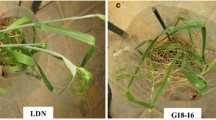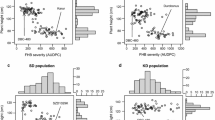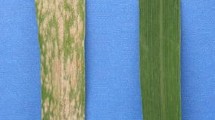Abstract
Introgression of several genomic loci from tetraploid Triticum militinae into bread wheat cv. Tähti has increased resistance of introgression line 8.1 to powdery mildew in seedlings and adult plants. In our previous work, only a major quantitative trait locus (QTL) on chromosome 4AL of the line 8.1 contributed significantly to resistance, whereas QTL on chromosomes 1A, 1B, 2A, 5A and 5B were detected merely on a suggestive level. To verify and characterize all QTLs in the line 8.1, a mapping population of double haploid lines was established. Testing for seedling resistance to 16 different races/mixtures of Blumeria graminis f. sp. tritici revealed four highly significant non-race-specific resistance QTL including the main QTL on chromosome 4AL, and a race-specific QTL on chromosome 5B. The major QTL on chromosome 4AL (QPm.tut-4A) as well as QTL on chromosome 5AL and a newly detected QTL on 7AL were highly effective at the adult stage. The QPm.tut-4A QTL accounts on average for 33–49 % of the variation in resistance in the double haploid population. Interactions between the main QTL QPm.tut-4A and the minor QTL were evaluated and discussed. A population of 98 F2 plants from a cross of susceptible cv. Chinese Spring and the line 8.1 was created that allowed mapping the QPm.tut-4A locus to the proximal 2.5-cM region of the introgressed segment on chromosome 4AL. The results obtained in this work make it feasible to use QPm.tut-4A in resistance breeding and provide a solid basis for positional cloning of the major QTL.



Similar content being viewed by others
References
Asíns MJ (2002) Present and future of quantitative trait locus analysis in plant breeding. Plant Breed 121:281–291
Badaeva ED, Budashkina EB, Bilinskaya EN, Pukhalskiy VA (2010) Intergenomic chromosome substitutions in wheat interspecific hybrids and their use in the development of genetic nomenclature of Triticum timopheevii chromosomes. Russ J Genet 46:869–886
Bent AF, Mackey D (2007) Elicitors, effectors and R-genes: the new paradigm and a lifetime supply of questions. Annu Rev Phytopathol 45:399–436
Bougot Y, Lemoine J, Pavoine MT, Guyomar’ch H, Gautier V, Muranty H, Barloy D (2006) A major QTL effect controlling resistance to powdery mildew in winter wheat at the adult plant stage. Plant Breed 125:550–556
Bryan GJ, Collins AJ, Stephenson P, Orry A, Smith JB, Gale MD (1997) Isolation and characterisation of microsatellites from hexaploid bread wheat. Theor Appl Genet 94:557–563
Canady MA, Ji Y, Chetelat RT (2006) Homeologous recombination in Solanum lycopersicoides introgression lines of cultivated tomato. Genetics 174(4):1775–1788
Chantret N, Mingeot D, Sourdille P, Bernard M, Jacquemin JM, Doussinault G (2001) A major QTL for powdery mildew resistance is stable over time and at two development stages in winter wheat. Theor Appl Genet 103:962–971
Chen XM, Luo YH, Xia XC, Xia LQ, Chen X, Ren ZL, He ZH, Jia JZ (2005) Chromosomal location of powdery mildew gene Pm16 in wheat using SSR marker analysis. Plant Breed 124:225–228
Chmielewicz KM, Manly KF (2002) User manual for QTX. Roswell Park Cancer Institute, Buffalo
Crossa J, Burgueño J, Dreisigacker S, Vargas M, Herrera-Foessel SA, Lillemo M, Singh RP, Trethowan R, Warburton M, Franco J, Reynolds M, Crouch JH, Ortiz R (2007) Association analysis of historical bread wheat germplasm using additive genetic covariance of relatives and population structure. Genetics 177:1889–1913
Devos KM, Dubcovsky J, Dvořák J, Chinoy CN, Gale MD (1995) Structural evolution of wheat chromosomes 4A, 5A, and 7B and its impact on recombination. Theor Appl Genet 91:282–288
Dobrovolskaya OB, Sourdille P, Bernard M, Salina EA (2009) Chromosome synteny of the A genome of two evolutionary wheat lines. Russ J Genet 45:1368–1375
Dorofeyev VF, Jakubtsiner MM, Rudenko MI, Migushova EF, Udachin RA, Merezhko AF, Semenova LV, Novikova MV, Gradchaninova OD, Shitova IP (1976) The wheats of the world. Brezhnev DD, Dorofeyev VF (eds) Kolos Publ., Leningrad, 487 pp (in Russian)
Dvořák J, Zhang HB (1990) Variation in repeated nucleotide sequences sheds light on the phylogeny of the wheat B and G genomes. Proc Natl Acad Sci USA 87:9640–9644
Dvořák J, di Terlizzi P, Zhang HB, Resta P (1993) The evolution of polyploid wheats: identification of the A genome donor species. Genome 36:21–31
Feuillet C, Langridge P, Waugh R (2008) Cereal breeding takes a walk on the wild side. Trends Genet 24:24–32
Gordeeva EI, Leonova IN, Kalinina NP, Salina EA, Budashkina EB (2009) Comparative cytological and molecular analysis of common wheat introgression lines containing genetic material of T. timopheevii Zhuk. Russ J Genet 45:1428–1437
Griffiths S, Sharp R, Foote TN, Bertin I, Wanous M, Reader S, Colas I, Moore G (2006) Molecular characterization of Ph1 as a major chromosome pairing locus in polyploid wheat. Nature 439:749–752
Gustafson GD, Shaner G (1982) Influence of plant age on the expression of slow-mildewing resistance in wheat. Phytopathology 72:746–749
Hossain KG, Kalavacharla V, Lazo GR, Hegstad J, Wentz MJ, Kianian PMA, Simons K, Gehlhar S, Rust JL, Syamala RR, Obeori K, Bhamidimarri S, Karunadharma P, Chao S, Anderson OD, Qi LL, Echalier B, Gill BS, Linkiewicz AM, Ratnasiri A, Dubcovsky J, Akhunov ED, Dvořák J, Miftahudin, Ross K, Gustafson JP, Radhawa HS, Dilbirligi M, Gill KS, Peng JH, Lapitan NLV, Greene RA, Bermudez-Kandianis CE, Sorrells ME, Feril O, Pathan MS, Nguyen HT, Gonzalez-Hernandez JL, Conley EJ, Anderson JA, Choi DW, Fenton D, Close TJ, McGuire PE, Qualset CO, Kianian SF (2004) A chromosome bin map of 2148 expressed sequence tag loci of wheat homoeologous group 7. Genetics 168:687–699
Hsam SLK, Zeller FJ (1997) Evidence of allelism between genes Pm8 and Pm17 and chromosomal location of powdery mildew and leaf rust resistance genes in the common wheat cultivar Amigo. Plant Breed 116:119–122
Hsam SLK, Zeller FJ (2002) Breeding for powdery mildew resistance in common wheat (Triticum aestivum L.). In: Bélanger RR, Bushnell WR, Dick AJ, Carver TLW (eds) The powdery mildews: a comprehensive treatise. American Phytopathological Society Press, St. Paul, pp 219–238
Huang XQ, Röder MS (2004) Molecular mapping of powdery mildew resistance genes in wheat: a review. Euphytica 137:203–223
Huang X, Zeller FJ, Hsam SLK, Wenzel G, Mohler V (2000) Chromosomal location of AFLP markers in common wheat utilizing nulli-tetrasomic stocks. Genome 43:298–305
Ishikawa G, Nakamura T, Ashida T, Saito M, Nsuda S, Endo TR (2009) Localization of anchor loci representing five hundred annotated rice genes to wheat chromosomes using PLUG markers. Theor Appl Genet 118:499–514
Jakobson I, Peusha H, Timofejeva L, Järve K (2006) Adult plant and seedling resistance to powdery mildew in a Triticum aestivum × Triticum militinae hybrid line. Theor Appl Genet 112:760–769
Järve K, Peusha HO, Tsymbalova J, Tamm S, Devos KM, Enno TM (2000) Chromosomal location of a T. timopheevii-derived powdery mildew resistance gene transferred to common wheat. Genome 43:377–381
Jiang J, Gill BS (1994a) Different species-specific chromosome translocation in Triticum timopheevii and T. turgidum support diphyletic origin of polyploid wheats. Chromosome Res 2:59–64
Jiang J, Gill BS (1994b) New 18S-26S ribosomal RNA gene loci: chromosomal landmarks for the evolution of polyploid wheats. Chromosoma 103:179-185. Chromosoma 103:179–185
Jorgensen JH, Jensen CJ (1973) Gene Pm6 for resistance to powdery mildew. Euphytica 22:423
Keller M, Keller B, Schachermayr G, Winzeler M, Schmid JE, Stamp P, Messmer MM (1999) Quantitative trait loci for resistance against powdery mildew in a segregating wheat × spelt population. Theor Appl Genet 98:903–912
Khlestkina EK, Kumar U, Röder MS (2010) Ent-kaurenoic acid oxidase genes in wheat. Mol Breed 25:251–258
Krattinger SG, Lagudah ES, Spielmeyer W, Singh RP, Huerta-Espino J, McFadden H, Bossolini E, Selter LL, Keller B (2009) A putative ABC transporter confers durable resistance to multiple fungal pathogens in wheat. Science 232:1360–1363
Krattinger SG, Lagudah ES, Wicker T, Risk JM, Ashton AR, Selter LL, Matsumoto T, Keller B (2011) Lr34 multi-pathogen resistance ABC transporter: molecular analysis of homoeologous and orthologous genes in hexaploid wheat and other grass species. Plant J 65:392–403
Kubaláková M, Valárik M, Barto J, Vrána J, Cíhalíková J, Molnár-Láng M, Dolezel J (2003) Analysis and sorting of rye (Secale cereale L.) chromosomes using flow cytometry. Genome 46(5):893–905
Lagudah ES, McFadden H, Singh RP, Huerta-Espino J, Bariana HS, Spielmeyer W (2006) Molecular genetic characterization of the Lr34/Yr18 slow rusting resistance gene region in wheat. Theor Appl Genet 114:21–30
Lan CX, Liang SS, Wang ZL, Yan J, Zhang Y, Xia XC, He ZH (2009) Quantitative trait loci mapping for adult-plant resistance to powdery mildew in Chinese wheat cultivar Bainong 64. Phytopathology 99:1121–1126
Lan CX, Ni X, Yan J, Zhang Y, Xia XC, Chen X, He ZH (2010) Quantitative trait loci mapping of adult-plant resistance to powdery mildew in Chinese wheat cultivar Lumai 21. Mol Breed 25:615–622
Large EC (1954) Growth stages in cereals. Illustrations of the Feeke’s scale. Plant Pathol 3:129
Lillemo M, Skinnes H, Brown JKM (2010) Race specific resistance to powdery mildew in Scandinavian wheat cultivars, breeding lines and introduced genotypes with partial resistance. Plant Breed 129:297–303
Lutz J, Limpert E, Bartoa P, Zeller FJ (1992) Identification of powdery mildew resistance genes in common wheat (Triticum aestivum L.) I. Czechoslovakian cultivars. Plant Breed 108:33–39
Maestra B, Naranjo T (1999) Structural chromosome differentiation between Triticum timopheevii and T. turgidum and T. aestivum. Theor Appl Genet 98:744–750
Maxwell JJ, Lyerly JH, Cowger C, Marshall D, Brown-Guedira G, Murphy JP (2009) MlAG12: a Triticum timopheevii-derived powdery mildew resistance gene in common wheat on chromosome 7AL. Theor Appl Genet 119:1489–1495
Meer JM, Manly KF, Cudmore RH (2002) Software for genetic mapping of Mendelian markers and quantitative trait loci. Roswell Park Cancer Institute, Buffalo
Mingeot D, Chantret N, Baret PV, Dekeyser A, Boukhatem N, Sourdille P, Doussinoult G, Jacquemin JM (2002) Mapping QTL involved in adult plant resistance to powdery mildew in the winter wheat line RE714 in two susceptible genetic background. Plant Breed 121:133–140
Muranty H, Pavoine M-T, Jaudeau B, Radek W, Doussinault G, Barloy D (2009) Two stable QTL involved in adult plant resistance to powdery mildew in the winter wheat line RE714 are expressed at different times along the growing season. Mol Breed 23:445–461
Naranjo T, Roca A, Goicoechea PG, Giraldez R (1987) Arm homeology of wheat and rye chromosomes. Genome 29:873–882
Perugini LD, Murphy JP, Marshall D, Brown-Guedira G (2008) Pm37, a new broadly effective powdery mildew resistance gene from Triticum timopheevii. Theor Appl Genet 116:417–425
Peusha H, Enno T, Jakobson I, Tsõmbalova J, Ingver A, Järve K (2008) Powdery mildew resistance of Nordic spring wheat cultivars grown in Estonia. Acta Agric Scand Sect B Plant Soil Sci 54:289–296
Robe P, Pavoine MT, Doussinault G (1996) Early assessment of adult plant reaction of wheat (Triticum aestivum L) to powdery mildew (Erysiphe graminis f sp tritici) at the five-leaf stage. Agronomie 16:441–451
Röder MS, Korzun V, Wendehake K, Plasche J, Tixier MH, Leroy P, Ganal MW (1998) A microsatellite map of wheat. Genetics 149:2007–2023
Rodriguez S, Perera E, Maestra B, Díez M, Naranjo T (2000) Chromosome structure of Triticum timopheevii relative to T. turgidum. Genome 43:923–930
Salina EA, Leonova IN, Efremova TT, Röder MS (2006) Wheat genome structure: translocations during the course of polyploidization. Funct Integr Genomics 6:71–80
Šimková H, Svensson JT, Condamine P, Hribová E, Suchánková P, Bhat PR, Bartos J, Safár J, Close TJ, Dolezel J (2008) Coupling amplified DNA from flow-sorted chromosomes to high-density SNP mapping in barley. BMC Genomics 9:294
Spielmeyer W, McIntosh RA, Kolmer J, Lagudah ES (2005) Powdery mildew resistance and Lr34/Yr18 genes for durable resistance to leaf and stripe rust cosegregate at a locus on the short arm of chromosome 7D of wheat. Theor Appl Genet 111:731–735
Srnić G, Murphy JP, Lyerly JH, Leath S, Marshall DS (2005) Inheritance and chromosomal assignment of powdery mildew resistance genes in two winter wheat germplasm lines. Crop Sci 45:1578
Tommasini L, Yahiaoui N, Srichumpa P, Keller B (2006) Development of functional markers specific for seven Pm3 resistance alleles and their validation in the bread wheat gene pool. Theor Appl Genet 114:165–175
Touraev A, Indrianto A, Wratschko I, Vicente O, Heberle-Bors E (1996) Efficient microspore embryogenesis in wheat (Triticum aestivum L.) induced by starvation at high temperature. Sex Plant Reprod 9:209–215
Tucker DM, Griffey CA, Liu S, Maroof MAS (2006) Potential for effective marker-assisted selection of three quantitative trait loci conferring adult plant resistance to powdery mildew in elite wheat breeding populations. Plant Breed 125:430–436
Tucker DM, Griffey CA, Liu S, Brown-Guedira G, Marshall DS, Saghai Maroof MA (2007) Confirmation of three quantitative trait loci conferring adult plant resistance to powdery mildew in two winter wheat populations. Euphytica 155:1–13
Vrána J, Kubaláková M, Šimková H, Cíhalíková J, Lysák MA, Dolezel J (2000) Flow sorting of mitotic chromosomes in common wheat (Triticum aestivum L.). Genetics 156(4):2033–2041
Yahiaoui N, Srichumpa P, Dudler R, Keller B (2004) Genome analysis at different ploidy levels allows cloning of the powdery mildew resistance gene Pm3b from hexaploid wheat. Plant J 37:528–538
Yu DZ, Yang XJ, Yang LJ, Jeger MJ, Brown JKM (2001) Assessment of partial resistance to powdery mildew in Chinese wheat varieties. Plant Breed 120:279–284
Acknowledgments
We thank Anne Ingver from the Jõgeva Plant Breeding Institute for the assistance in conducting field tests. This study was supported by the European Commission through European Regional Fund (Estonian Centre of Excellence in Environmental Adaptation), Estonian Ministry of Agriculture, the Ministry of Education, Youth and Sports of the Czech Republic and the European Regional Development Fund (Operational Programme Research and Development for Innovations No. ED0007/01/01), and by Czech Science Foundation (Award No. 521/08/1629).
Author information
Authors and Affiliations
Corresponding author
Additional information
Communicated by J. Dubcovsky.
Electronic supplementary material
Below is the link to the electronic supplementary material.
Rights and permissions
About this article
Cite this article
Jakobson, I., Reis, D., Tiidema, A. et al. Fine mapping, phenotypic characterization and validation of non-race-specific resistance to powdery mildew in a wheat–Triticum militinae introgression line. Theor Appl Genet 125, 609–623 (2012). https://doi.org/10.1007/s00122-012-1856-0
Received:
Accepted:
Published:
Issue Date:
DOI: https://doi.org/10.1007/s00122-012-1856-0




